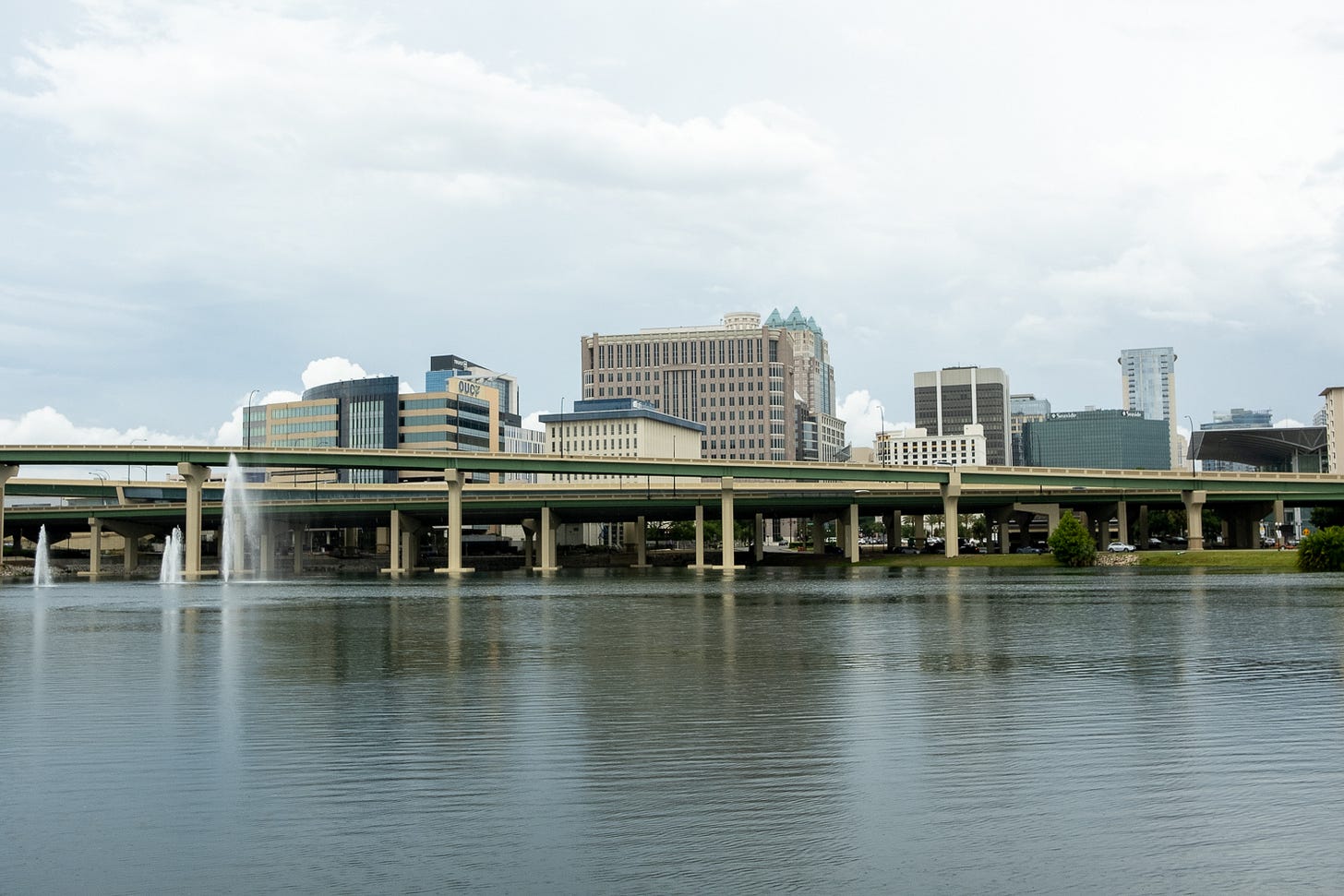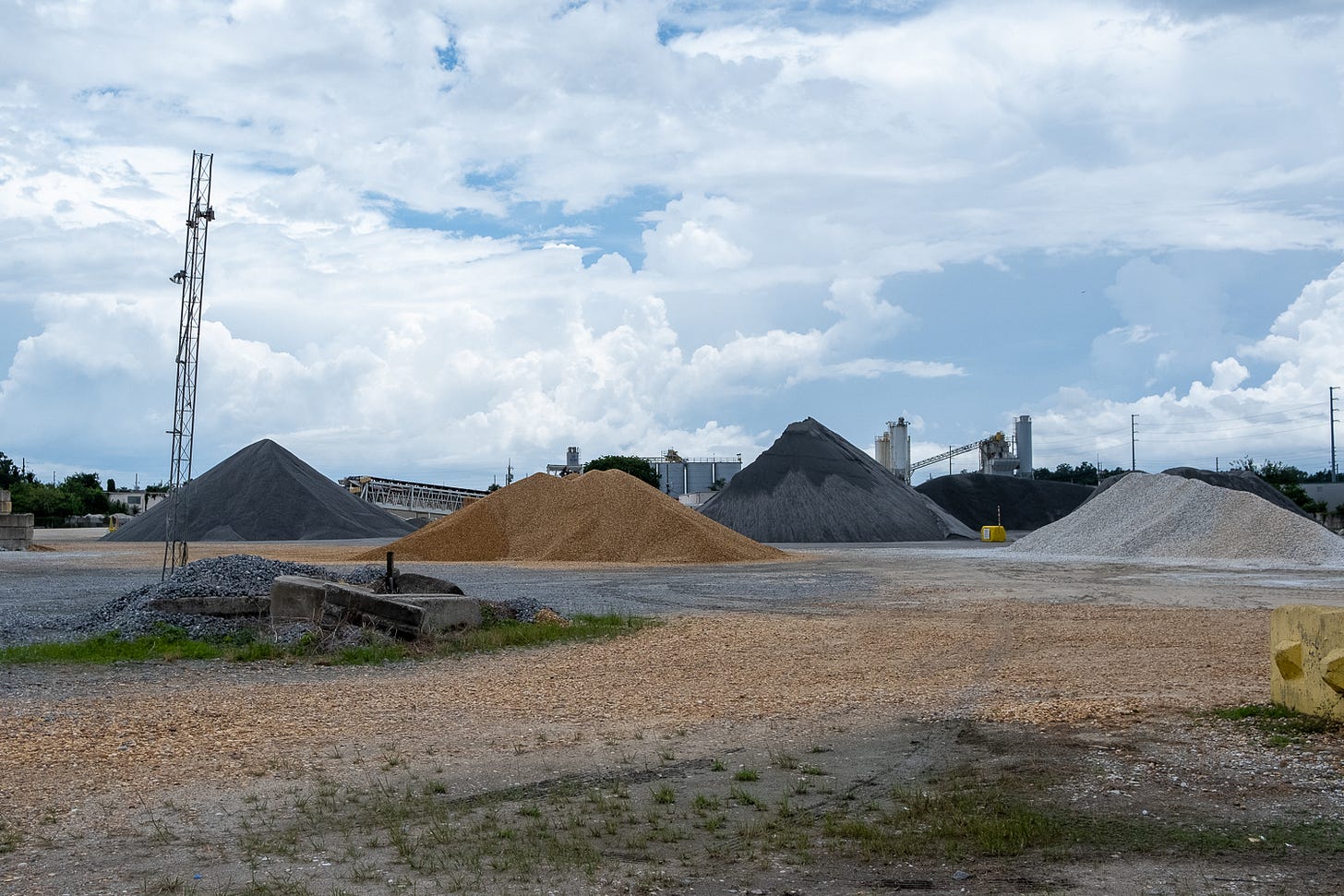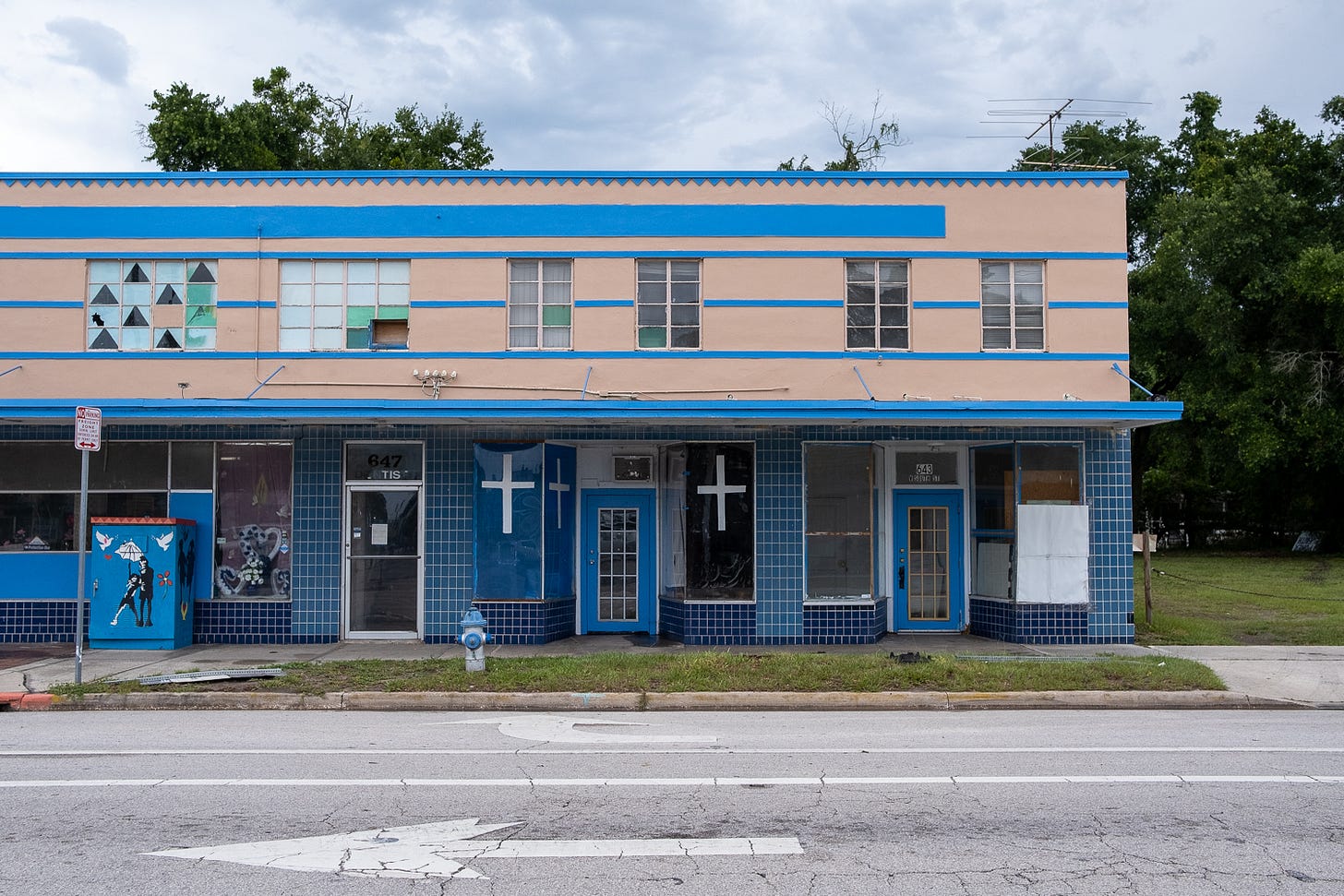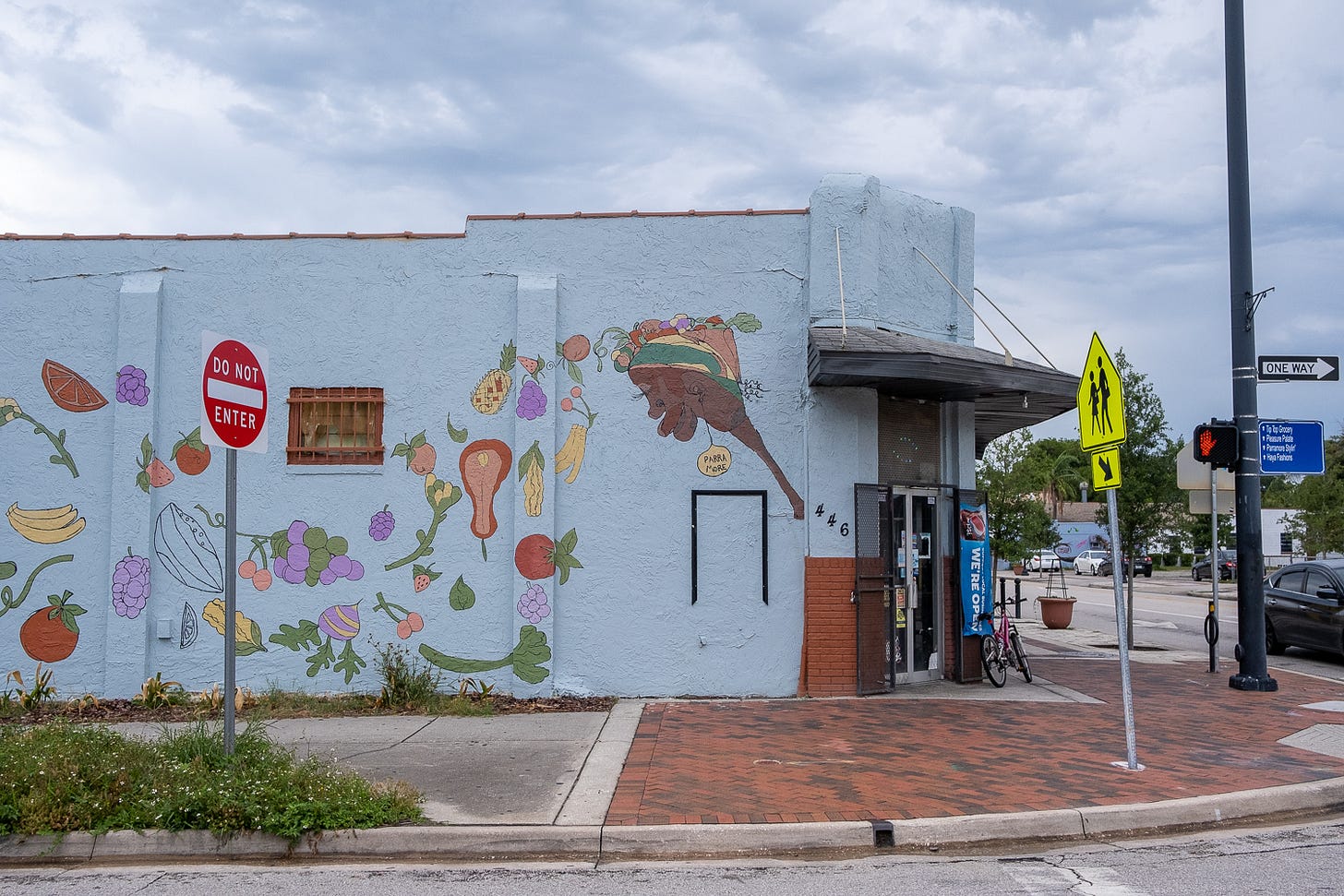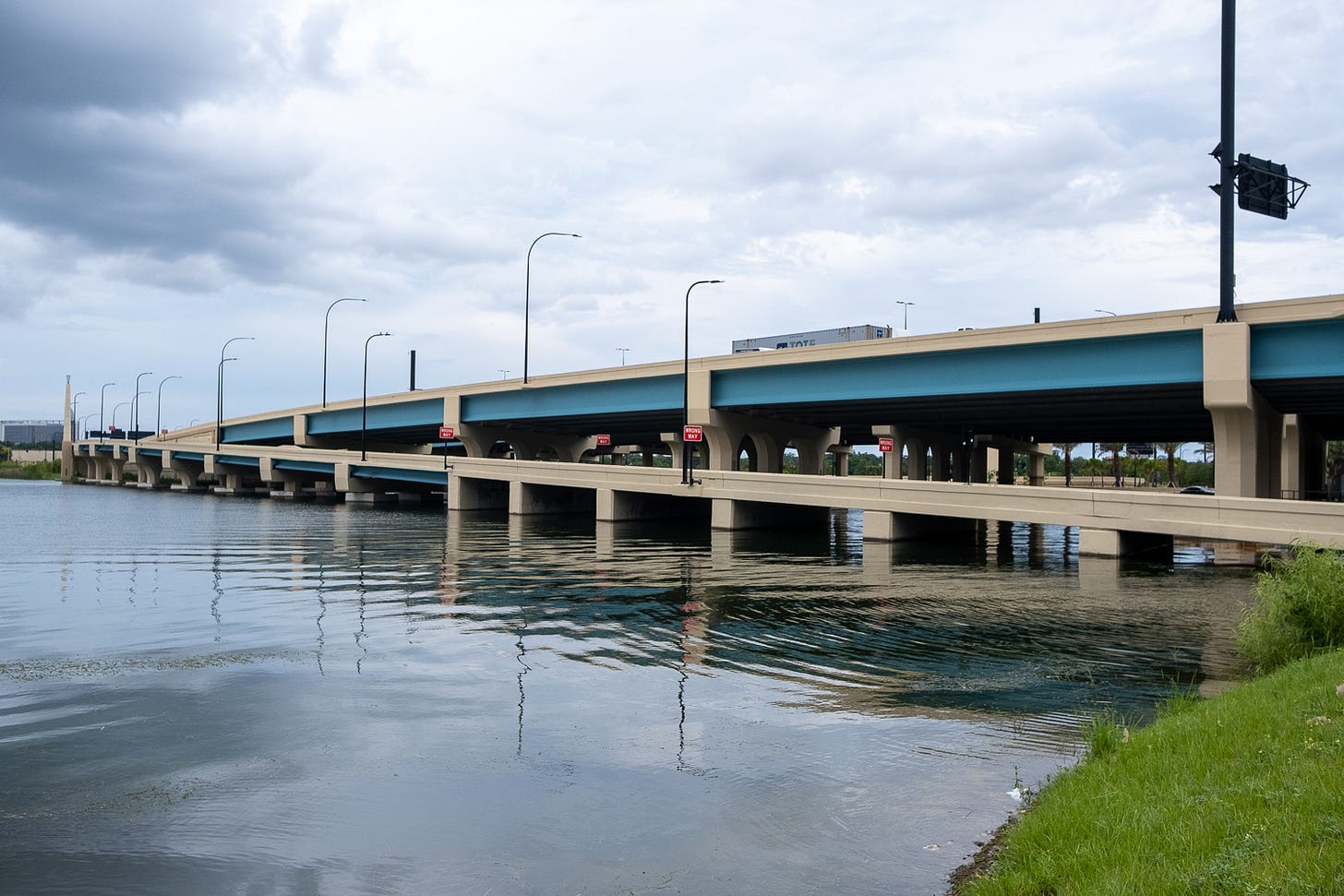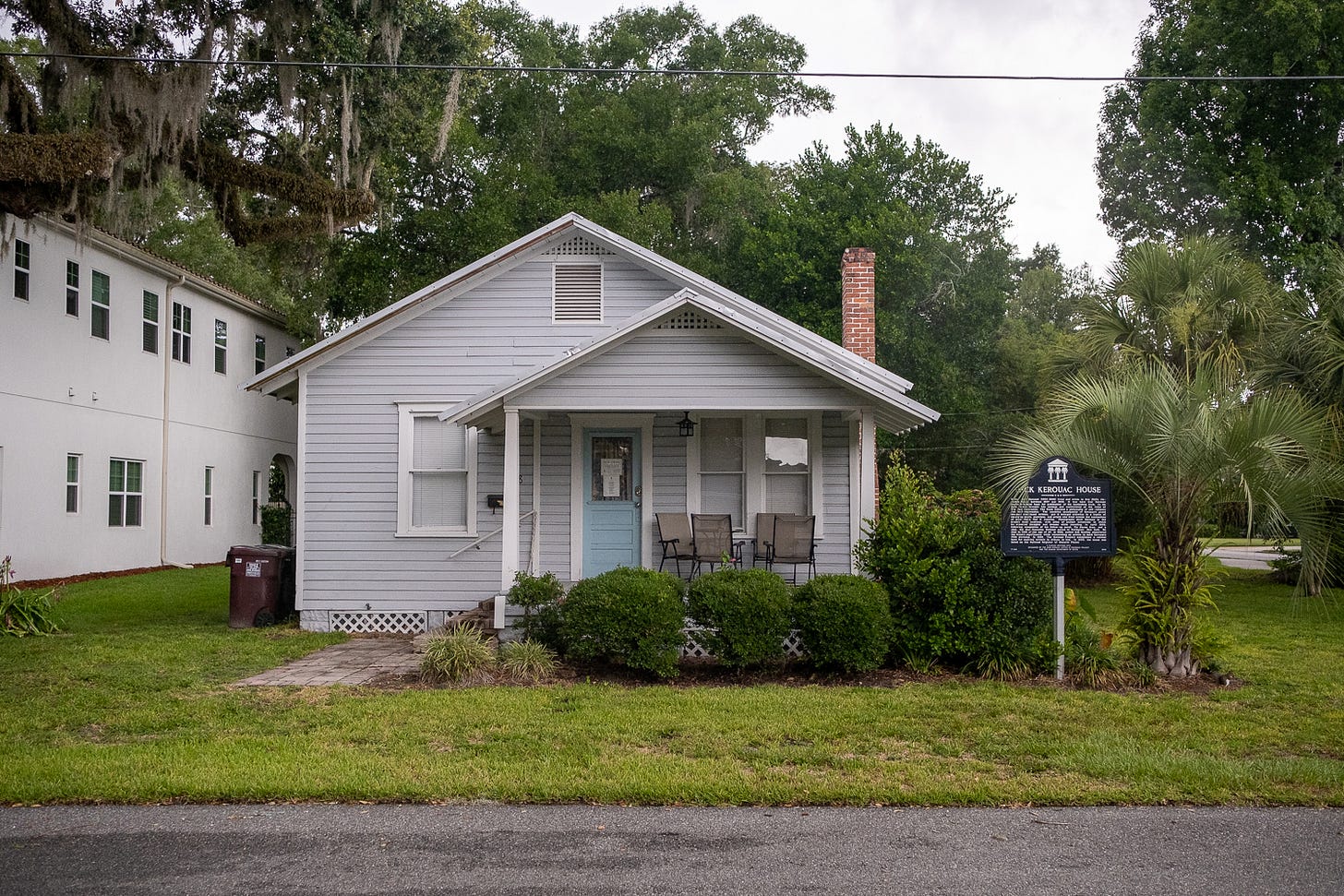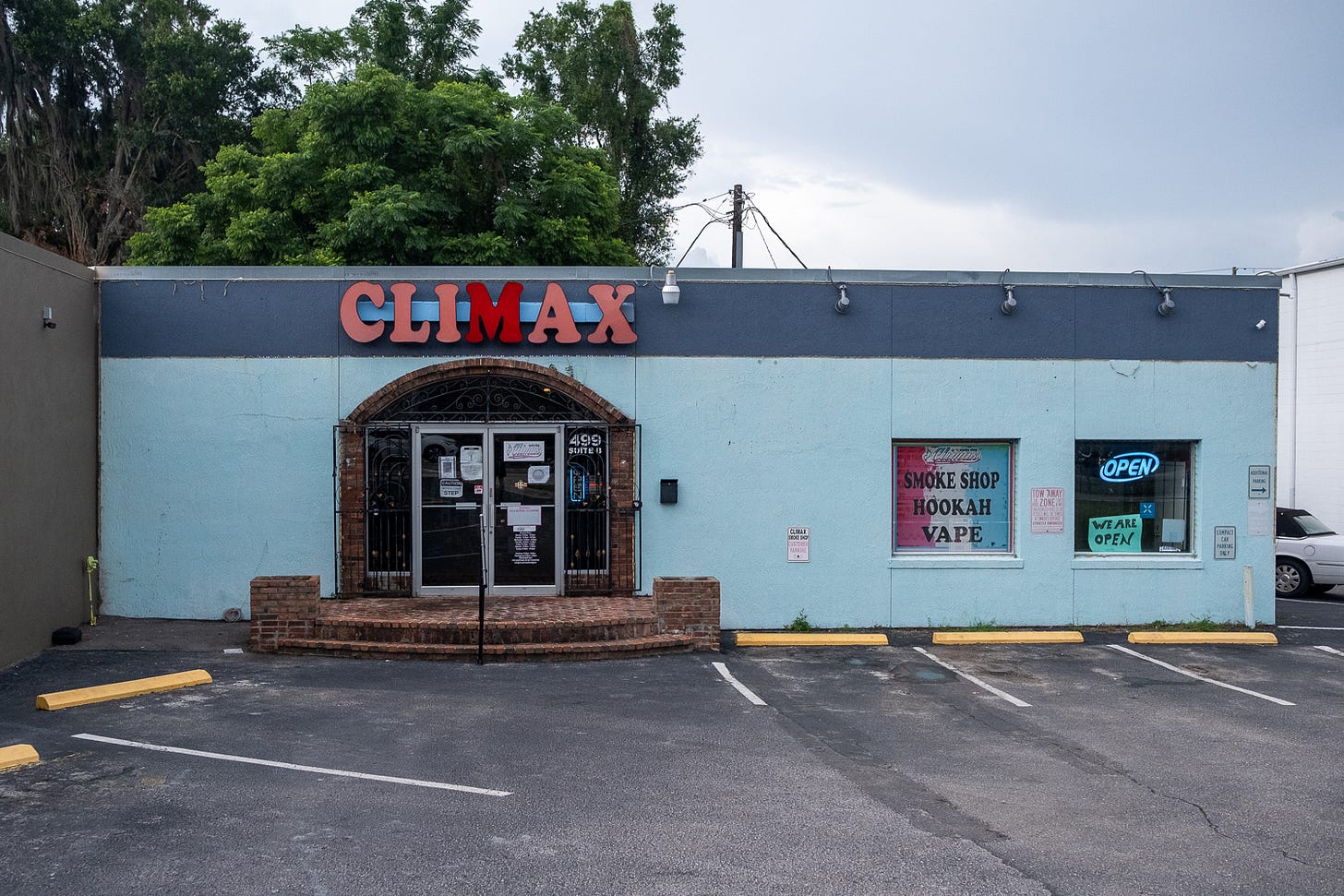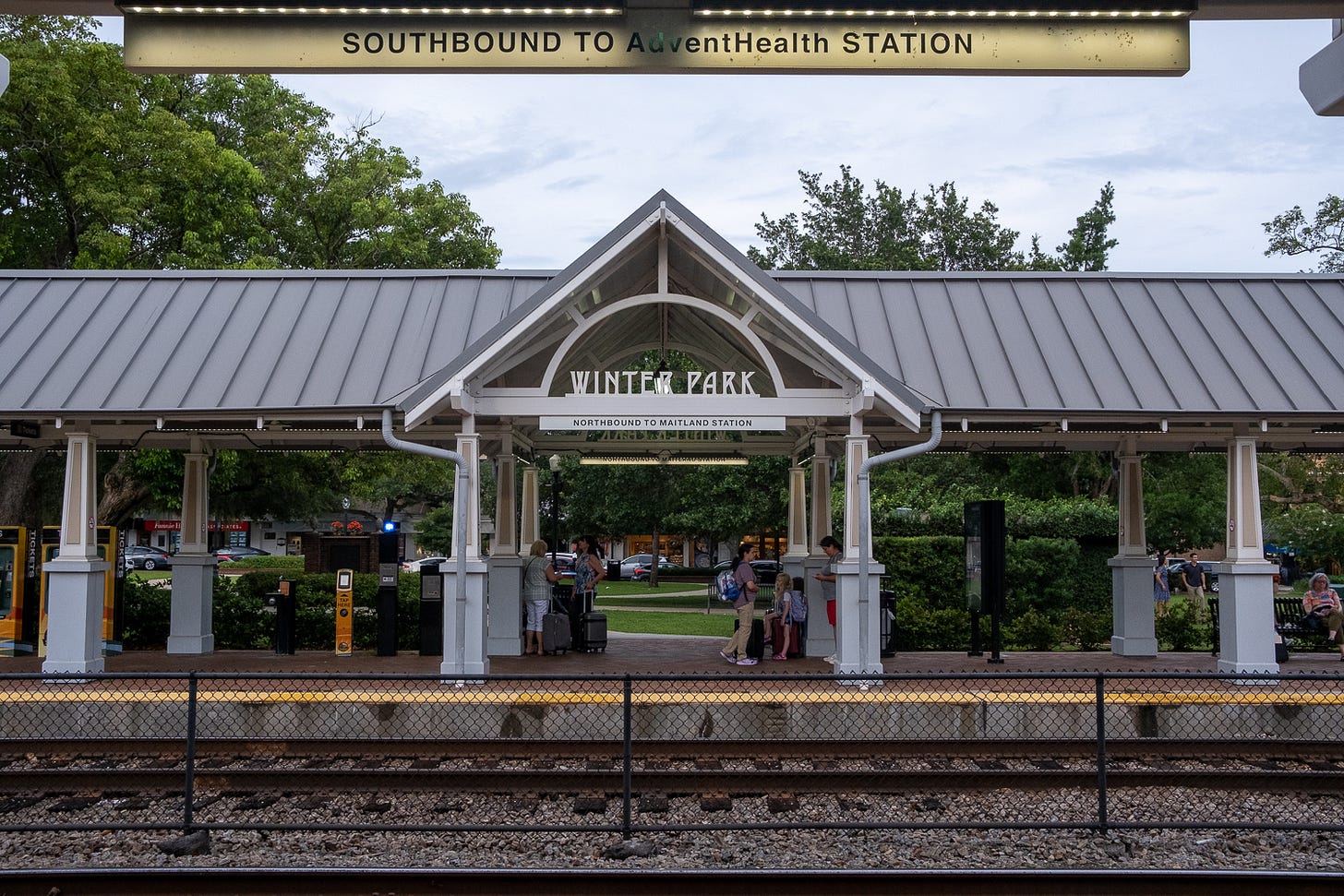SUN SONG 27: Rain or Shine
Panera Bread bathrooms, Dharma Bums, Pulse Memorial.
June 10th, 2022
Orlando, FL
17.03 miles
For a city commonly associated with Disney World, there is little trace within downtown Orlando that would make one believe the theme park even exists. Save for one bus shuttling visitors to the park, I didn’t encounter a single bit of Disney during my entire day. Instead, Orlando is better defined by I-4, the major highway dividing the city in half. For the very few who choose to walk this city, it’s almost impossible to avoid.
The rain, on the other hand, might give I-4 a run for its money. June is considered the rainiest month here in central Florida. I knew I was bound to walk in the rain at some point, but didn’t understand the frequency at which it would come and go. Not to mention, how heavily it would fall.
I wanted to start the day by taking a bus down to a Wawa gas station in a neighborhood called Pine Loch on the southern edge of town. From there I would move my way north to Winter Park, a nearby suburb, but the weather had plans otherwise.
I walked downtown, but once underneath the bus shelter, all the sunshine disappeared and it began to rain…and I mean RAIN. It was raining cats and dogs. An absolute monsoon. Most assume you can’t walk Orlando because of the lack of pedestrian infrastructure, but maybe the weather had something to do with it too. It was about lunch time and there were office workers running across the street and seeking refuge on just about every street corner. I ducked beneath the awning of a parking garage and started reconsidering my intentions. Was I really gonna walk in this rain? Had I not had a day off in Savannah the day before, I may have considered calling it off, but who did I think I was? The show must go on.
I was in no real hurry to begin, so I grabbed a sandwich in a deli right beside the parking garage. It was appropriately named New York Deli. Along this journey I’ve noticed nearly every city has a store named New York Deli, but all bear little resemblance to those within the Big Apple. Regardless, I find it comforting and enjoy experiencing a business owner's interpretation. I would see two separate New York Delis on this walk.
The guy who owned this shop was from Niagara Falls and rambled a monologue about how all the ingredients in the sandwiches were natural. I ordered a Rueben and was given a complimentary pickle. From the window, I sat munching on my sandwich and watching the rain fall hoping for the weather to break. Damn, I’m really about to walk in that huh? I zipped up my rain jacket, packed my things in a waterproof dry sack and busted through the front door.
I chose not to ride the bus to Wawa and cut my route a little short. Instead, I’d walk south of downtown and make a visit to the Pulse Nightclub memorial a couple miles away. It was unintentional, but I’m leaving Orlando on the day of the Pulse shooting anniversary. Understandably, given this is Pride month, there’s been a lot of buzz around the city. I felt it was appropriate to visit and pay my respects.
I didn’t write about it, but while in Charleston I stopped at the Emanuel African Methodist Episcopal Church, the same church where 9 Black Americans were killed during bible study by white supremacist Dylann Roof in 2015.
Visiting these places isn’t pleasant. Especially in light of recent events in Buffalo, NY and Uvalde, TX. The media (and frequency of shootings) has desensitized many Americans making it all too easy to ignore these incidents. I can’t blame people. It’s difficult to stomach, but being at the site of a shooting makes it real. Walking to these places elicits emotions I didn’t know I had and really just makes me sad. I mourn those who were senselessly killed. Inevitably, these shootings are not the defining features of Charleston or Orlando, but they have a way of shaping a city and effect its residents. It’s something to think about while walking around the city.
Pulse Nightclub is no longer operating, but is still intact. The club sits beside Orange Ave, which is an arterial road filled with traffic and chain businesses. A Dunkin Donuts sits across the street. Presently, a barrier encloses the nightclub and is covered with flowers, photographs, and mementos honoring those who lost their lives. Benches have been installed to sit and reflect. The Pulse sign is covered in messages written in sharpie marker from those who visited. I was one of maybe 10 visitors and the grounds were very quiet. Not a word spoken.
In the back was a kiosk where you could make donations. That’s where I met Jimmy and Cindy, two volunteers with the onePulse Foundation. For such a solemn memorial, they were chipper and talkative. Jimmy had the bluest eyes I’d ever seen (he confessed they were contacts) and offered me a sandwich (which I gladly took). Cindy was from Philadelphia, although Orlando was her home, and told me all the places I should (and should not) visit during my walk.
Stay east of I-4! Be safe, hun!
It’s difficult arriving in a new city and knowing who’s judgment to trust. Without spending time on the ground, I don’t want to deem certain places unsafe or dangerous. Not to mention, unsafe and dangerous are relative terms and really depend on your own personal experience. I’ve lived in cities with their share of crime and felt pretty safe in the “dangerous” parts of other cities.
Crime happens everywhere and unfortunately I still feel a little on edge after being assaulted in Baltimore. Being so, other’s judgment holds a little more weight than it previously would. A chunk of this work was already about challenging my fears (hey now, it can feel pretty vulnerable walking the sidewalks – especially in America), but I anticipate I’ll carry these feelings for a little while and try not to let it affect my experience of walking in new cities.
I continued up Parramore Avenue, which does pass through the eastern edge of Parramore (one of the neighborhoods Cindy told me to avoid). Many of the homes in the area are built of cinder block, a common material used in Florida homes. The neighborhood is defined by Exploria Stadium and can be seen in the distance. Say whatever you will about Paramore, but I saw more people hanging out in their yards or on the sidewalk than all the neighborhoods I’ve walked in Orlando. Residents said hello to me (likely because I looked like a lost tourist). Instead of manicured lawns and nice new siding, many of the homes actually looked lived in, even if the neighborhood was a little down and out.
A common theme of Orlando – if you’re walking on foot – is absence. There’s plenty of traffic, but not a soul walking the street. Older parts of the city, like Eola Heights, Downtown, or Thornton Park are fairly walkable and do support some pedestrian activity, yet there is no incentive to walk elsewhere as it’s either not enjoyable or lacks the infrastructure.
Like most of the Sun Belt, Orlando grew rapidly in the latter half of the 20th Century. With the development of air conditioning meant more manufacturing and industry to relocate south, bringing an influx of new residents seeking economic opportunity, a warmer climate, and a place to retire. Like many developments built post 1945, much of the city was designed to accommodate automobile traffic. To walk Orlando is to be at the mercy of long crosswalks, exhaust, and massive interstate structures.
Nobody looks for me as I approach the crosswalk, especially those who are making a right turn. It’s all so predictable, like the Montauk Highway (the road I followed to traverse the entire length of Long Island) on steroids. It seems massive pickup trucks and Teslas are the vehicles of choice. As I walk, I see countless people barreling down the road at high speeds (the speed limit is just a suggestion here) with their eyes buried in their cell phone.
There are beautiful buildings here, but most of it feels like it was built recently and as cheap as possible. These developments aren’t unique to Orlando and are common in pretty much every city across America with a growing population, but here it is built in such large quantities. I find these places so fascinating, especially in a place like Florida, where there is an abundance of wildlife and tropical foliage. Seeing a highway or endless sprawl of big box stores just feels especially potent. I take so many photos of the landscape and wonder if people are confused and asking what the hell I’m doing.
Most of the people I encounter on the sidewalk are the homeless, those who cannot afford cars and must rely on public transportation, construction workers (there’s so much being built) and lastly grounds keepers (mowing is a big deal in Orlando). I keep walking in one direction for miles, save for a detour to Jack Kerouac’s former residence (where he wrote The Dharma Bums) and I weave through numerous neighborhoods (many of which feel like suburban subdivisions). The homes bear signs which read “No trespassing” or “Private property”, which makes me wonder who exactly these signs are for.
I’m well outside of the bodega belt (or cornerstore belt, depending on which city you're in. This is a new term I’ve coined for cities north of Richmond, Virginia), meaning there are few and far places to purchase a bottle of water or a place to pee. I often have to walk long stretches until reaching a gas station at a busy intersection. Surprisingly, Panera Bread has become my savior in Orlando. I encountered two on this day’s walk, both without bathroom codes and no hassle from employees who insist I purchase something first.
I chose to walk all the way to Winter Park because I read it was one of Orlando’s most walkable suburbs. Given how close it is to Orlando proper, I felt it was worth the trip.
It’s unlike any place I’ve seen here so far. There is a proper mainstreet which bolsters many different shops, numerous crosswalks (although they just read “walk” and “wait”), an abundance of greenspace and a golf course. The area is serviced by the Sunrail, which is the commuter rail for metro Orlando. While not nearly extensive, it’s similar to New York’s Metro-North or Chicago’s Metra. I thought about grabbing a bite to eat, but I was covered in sweat and sunburnt. The restaurants along the mainstreet were a little more high end than I was seeking. I could have continued going, but my time walking Winter Park was cut short as the Sunrail runs every half-hour and it was about to arrive.
So, I took a break in the park across from a peacock water fountain (the peacock is the symbol of Winter Park) and waited for the train.
That’s all I’ve got for yesterdays’ walk. I think I could write volumes on Orlando. Today was another fruitful, but rainy walk. I’ll likely send the recap later in the afternoon as I have a seven hour train ride to Miami – the final leg of this long, long walk. Today (June 11th) was full of strange encounters…a different kind of day than the one I described in this letter. Now it’s time for bed. I can’t believe this walk is almost over. Four more days…
Signing off,
–Alex


